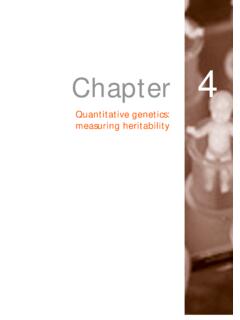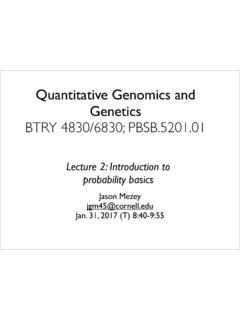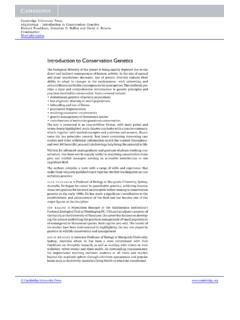Transcription of Lecture Notes in Population Genetics - …
1 Lecture NotesinPopulation GeneticsKent E. HolsingerDepartment of Ecology & Evolutionary Biology, U-3043 University of ConnecticutStorrs, CT 06269-3043c 2001-2015 Kent E. HolsingerCreative Commons LicenseThese Notes are licensed under the Creative Commons Attribution License. To view a copy of thislicense, visit or send a letter to Creative Commons,559 Nathan Abbott Way, Stanford, California 94305, The genetic structure of populations11 genetic transmission in populations32 The Hardy-Weinberg Principle and estimating allele frequencies73 Inbreeding and self-fertilization214 Testing Hardy-Weinberg315 Analyzing the genetic structure of populations396 Analyzing the genetic structure of populations: a Bayesian approach537 Analyzing the genetic structure of populations: individual assignment618 Two-locus Population genetics67II The Genetics of natural selection759 The Genetics of Natural Selection7710 Estimating viability8911 Selection at one locus with many alleles, fertility selection, and sexualselection95iiiIII genetic drift10312 genetic Drift10513 Mutation, Migration, and genetic Drift11914 Selection and genetic drift12515 The Coalescent129IV quantitative genetics13516 Introduction to quantitative genetics13717 Resemblance among relatives14718 Evolution of quantitative traits15719 Selection on multiple characters16520 Association mapping.
2 The background from two-locus genetics173V Molecular evolution18321 Introduction to molecular Population genetics18522 Patterns of nucleotide and amino acid substitution199VI Phylogeography21723 AMOVA and Statistical phylogeography21924 Population genomics24125 genetic structure of human populations in Great Britain253ivPrefaceAcknowledgmentsI ve used various versions of these Notes in my graduate course on Population since 2001. Some of them date back even earlier thanthat. Several generations of students and teaching assistants have found errors and helpedme to find better ways of explaining arcane concepts. In addition, the following people havefound various errors and helped me to correct CadyNora MitchellRachel PrunierUzay SezenRobynn ShannonJennifer SteinbachsKathryn TheissYufeng WuI am indebted to everyone who has found errors or suggested better ways of explainingconcepts, but don t blame them for any errors that are left.
3 Those are all IThe genetic structure of populations1 Chapter 1 genetic transmission in populationsMendel s rules describe how genetic transmission happens between parents and a monohybrid cross:A1A2 A1A2 14A1A112A1A214A2A2 Population Genetics describes how genetic transmission happens between apopulationofparents and a Population of offspring. Consider the following data from theEst-3 locus ofZoarces viviparus:1 Genotype of offspringMaternal genotypeA1A1A1A2A2A2A1A1305516A1A2459136 0877A2A28771541 This table describes, empirically, the relationship between the genotypes of mothers and thegenotypes of their offspring. We can also make some inferences about the genotypes of thefathers in this Population , even though we didn t see 305 out of 821 male gametes that fertilized eggs fromA1A1mothers carried theA1allele (37%).2. 877 out of 2418 male gametes that fertilized eggs fromA2A2mothers carried theA1allele (36%).
4 1from [10]3 QuestionHow many of the 2,696 male gametes that fertilized eggs fromA1A2motherscarried theA1allele?RecallWe don t know the paternal genotypes or we wouldn t be asking this question. There is no way to tell which of the 1360A1A2offspring receivedA1from theirmother and which from their father. Regardless of what the genotype of the father is, half of the offspring of a het-erozygous mother will be Heterozygous offspring of heterozygous mothers contain no information aboutthe frequency ofA1among fathers, so we don t bother to include them in many of the 1336 homozygous progeny of heterozygous mothers receivedanA1allele from their father?Answer459 out of 1336 (34%)New questionHow many of the offspring where the paternal contribution can be identifiedreceived anA1allele from their father?Answer(305 + 459 + 877) out of (305 + 459 + 877 + 516 + 877 + 1541) or 1641 out of4575 (36%)An algebraic formulation of the problemThe above calculations tell us what s happening for this particular data set, but those of youwho know me know that there has to be a little math coming to describe the situation moregenerally.
5 Here it is:Genotype NumberSexA1A1F11femaleA1A2F12femaleA2A2F 22femaleA1A1M11maleA1A2M12maleA2A2M22mal e2 Assuming we re looking at data from a locus that has only two alleles. If there were four alleles at alocus, for example,allof the offspring might be +F122F11+2F12+2F22qf=2F22+F122F11+2F12+2 F22pm=2M11+M122M11+2M12+2M22qm=2M22+M122 M11+2M12+2M22,wherepfis the frequency ofA1in mothers andpmis the frequency ofA1in every individual in the Population must have one father and one mother, thefrequency ofA1among offspring is the same in both sexes, namelyp=12(pf+pm),assuming that all matings have the same average fecundity and that the locus we re studyingis : Why do those assumptions matter?Answer: Ifpf=pm, then the allele frequency among offspring is equal to the allelefrequency in their parents, , the allele frequency doesn t change from one generation tothe next.
6 This might be considered the First Law of Population Genetics : If no forces act tochange allele frequencies between zygote formation and breeding, allele frequencies will force lawsThis is an example of what philosophers call azero force law. Zero force laws play a veryimportant role in scientific theories, because we can t begin to understand what a force doesuntil we understand what would happen in the absence of any forces. Consider Newton sfamous dictum:An object in motion tends to remain in motion in a straight line. An object atrest tends to remain at (as you may remember from introductory physics)5F=ma .3qf= 1 pfandqm= 1 pmas that there are enough offspring produced that we can ignore genetic drift. Have you noticed that Ihave a fondness for footnotes? You ll see a lot more before the semester is through, and you ll soon discoverthat most of my weak attempts at humor are buried in t worry if you re not good at physics.
7 I m probably worse. What I m about to tell you is almostthe only thing about physics I can we observe an object accelerating, we can immediately infer that a force is acting on it,and we can infer something about the magnitude of that , if an object isnot accelerating we cannot conclude that no forces are acting. It might be that opposingforces act on the object in such a way that the resultant is nonetforce. Acceleration is asufficientcondition to infer that force is operating on an object, but it is we might call the First Law of Population Genetics is analogous to Newton sFirst Law of Motion:If all genotypes at a particular locus have the same average fecundity and thesame average chance of being included in the breeding Population , allele frequen-cies in the Population will remain the rest of the semester we ll be learning about the forces that cause allele frequencies tochange and learning how to infer the properties of those forces from the changes that theyinduce.
8 But you must always remember that while we can infer that some evolutionary forceis present if allele frequencies change from one generation to the next, wecannotinfer theabsence of a force from a lack of allele frequency 2 The Hardy-Weinberg Principle andestimating allele frequenciesTo keep things relatively simple, we ll spend much of our time in this course talking aboutvariation at a single genetic locus, even though alleles at many different loci are involved inexpression of most morphological or physiological traits. We ll spend about three weeks inmid-October studying the Genetics of quantitative variation, but until then you can asssumethat I m talking about variation at a single locus unless I specifically say genetic composition of populationsWhen I talk about the genetic composition of a Population , I m referring to three aspects ofvariation within that Population :11.
9 The number of alleles at a The frequency of alleles at the The frequency of genotypes at the may not be immediately obvious why we need both (2) and (3) to describe the geneticcomposition of a Population , so let me illustrate with two hypothetical populations:A1A1A1A2A2A2 Population 150050 Population 22550251At each locus I m talking about. Remember, I m only talking about one locus at a time, unless Ispecifically say otherwise. We ll see why this matters when we get to two-locus Genetics in a few s easy to see that the frequency ofA1is in both populations,2but the genotypefrequencies are very different. In point of fact, we don t need both genotype and allelefrequencies. We can always calculate allele frequencies from genotype frequencies, but wecan t do the reverse of the Hardy-Weinberg principleWe saw last time using the data fromZoarces viviparusthat we can describe empirically andalgebraically how genotype frequencies in one generation are related to genotype frequenciesin the next.
10 Let s explore that a bit further. To do so we re going to use a technique that isbroadly useful in Population Genetics , , we re going to construct a mating table. A matingtable consists of three components:1. A list of all possible genotype The frequency with which each genotype pairing The genotypes produced by each genotypeMating FrequencyA1A1A1A2A2A2A1A1 A1A1x211100A1A2x11x1212120A2A2x11x22010A 1A2 A1A1x12x1112120A1A2x212141214A2A2x12x220 1212A2A2 A1A1x22x11010A1A2x22x1201212A2A2x222001 Believe it or not, in constructing this table we ve already made three assumptions about thetransmission of genetic variation from one generation to the next:Assumption #1 Genotype frequencies are the same in males and females, ,x11is thefrequency of theA1A1genotype in both males and 2(50)/200 = ,p2= (2(25) + 50)/200 = would be easy enough to relax this assumption, but it makes the algebra more complicated withoutproviding any new insight, so we won t bother with relaxing it unless someone #2 Genotypes mate at randomwith respect to their genotype at this partic-ular #3 Meiosis is fair.









